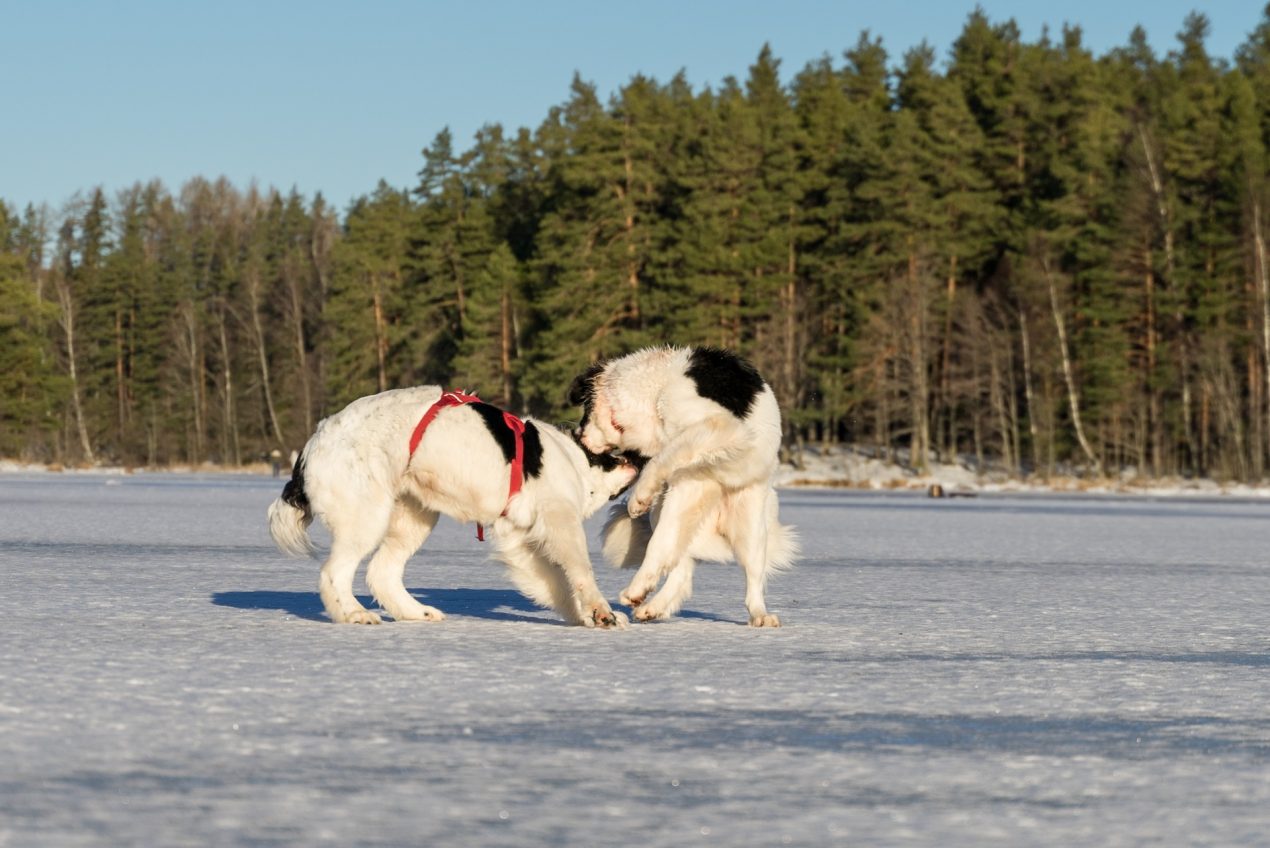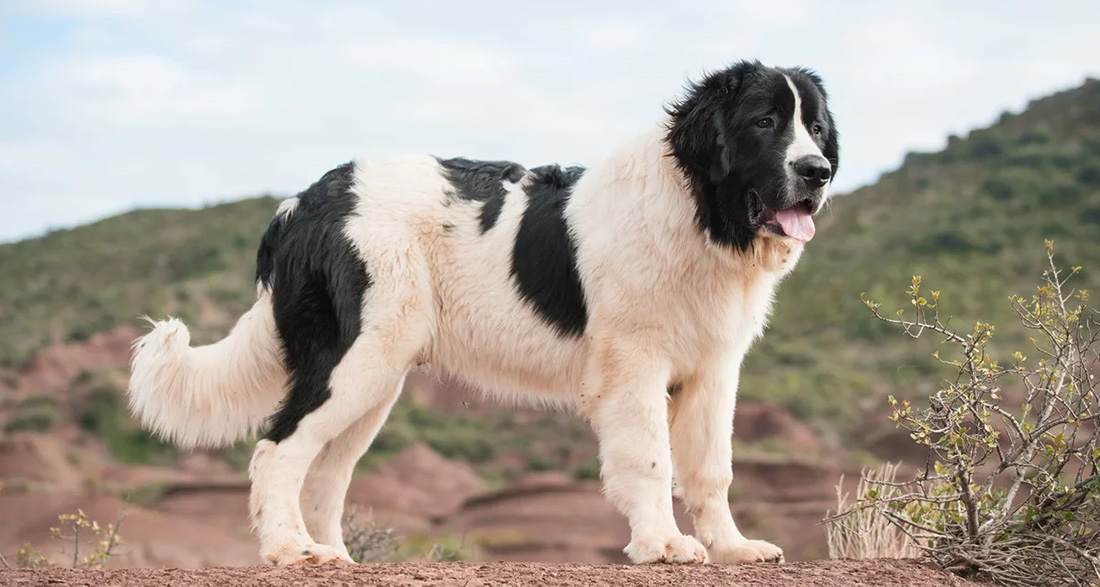With its impressive appearance, the good-natured Landseer certainly makes an impression. However, it’s the lovable nature of this water-loving giant that will truly impress you. Despite its independence, the Landseer is extremely people-oriented and a fantastic family dog, seemingly devoid of any aggression.
History of the Landseer
The roots of the Landseer extend far into the past. For a long time, the Landseer was counted among the Newfoundland dogs, originating from the Canadian Atlantic island of Newfoundland and arriving in England from there. British fishermen valued them as reliable helpers, as the Newfoundland dog, being water-savvy, was the perfect companion for fishermen.
Over time, the original dogs from Newfoundland were likely crossed with European-descended dogs of the fishermen. Today, it is believed that Newfoundland dogs, Landseers, and Pyrenean Mountain Dogs share common ancestors.
However, these new dogs not only impressed the fishermen but also found their way into the homes of the nobility and bourgeoisie, leading to the establishment of a “Newfoundland Club” in England in 1886. Standards were set here, and selective breeding began. By the end of the 19th century, the black-and-white Newfoundland dog was almost forgotten in England, as the dominant inheritance prevailed, resulting in few puppies with black-and-white fur.
We owe the Landseer with its white and black fur to cynologists from Germany and Switzerland who discovered and utilized the variant of the Newfoundland breed that was hardly used for breeding in England. Thus, the gentle giants not only came to Continental Europe but were also used for the pure breeding of the black-and-white type. To clearly highlight the pure breeding of the type and distinguish it from the original Newfoundland dogs with black-and-white fur, the breeders named the new breed Landseer.
The namesake here was the painter Edwin Landseer. The painter was known for his animal paintings, in which he often depicted black-and-white dogs. The Landseer was recognized as a separate breed by the FCI in 1960. However, there are still Newfoundland dogs with black-and-white coloring, although they still remain the minority.
Breed Overview
GROUP: Working
HEIGHT: 26 to 32 inches
WEIGHT: 100 to 156 pounds
COAT: Longhair
COAT COLOR: Black and white
LIFE SPAN: 9 to 14 years
TEMPERAMENT: Balanced, Alert, Intelligent
HYPOALLERGENIC: No
ORIGIN: Germany and Switzerland
Character and Temperament
Due to their common ancestors, Landseers and Newfoundland dogs remain very similar to this day. However, there are also differences, and the Landseer is considered more agile. You will quickly notice that just the sight of a Landseer can have a relaxing effect. This is because the Landseer exudes a fascinating serenity that is unparalleled. Not only does its appearance radiate serenity, but the Landseer is also inherently good-natured and friendly.
As a people-oriented furry companion, the stately Landseer is extremely affectionate and loves children. Thus, the gentle giant is a friendly family dog, a faithful and reliable companion for all family members. Despite its good nature and stable character, the alert Landseer can differentiate between friend and foe and can become an intrepid protector when needed. Thus, the dogs can act decisively to protect their “loved ones.”
The love for water seems deeply rooted in the genes of this seemingly leisurely dog. Thus, the Landseer is considered an excellent swimmer and can easily rescue people from drowning. Their intelligence and ability to make decisions on their own continue to ensure that these animals are trained and used as water rescue dogs.
Acquiring a Landseer
If you’re enthusiastic about the Landseer dog, then you should not only consider the acquisition costs of around $1,400 but also be aware that the large dog also requires a considerable amount of food. In addition to monthly expenses, you should also factor in regular visits to the veterinarian and be sure that you can provide a loving home for the Landseer for the next 9 to 14 years or possibly more.
Unfortunately, there are always Landseers in need, despite their loving nature, waiting for adoption in animal shelters. If you’re not set on getting a puppy, you can also adopt a Landseer dog from an animal shelter, as the Landseer will thank you and shower you with all their love and affection.
What should I consider when buying?
If you decide to get a Landseer puppy, you should visit the breeder beforehand. Pay attention not only to the pedigree but also ask to see the veterinary records of the puppies and the parent animals. Also, don’t just focus on the puppies, but take a closer look at the parent animals. Healthy and agile parent animals are the best prerequisite for healthy, agile puppies.
Don’t hesitate to ask the breeder questions, and be prepared for reputable breeders to ask you some questions as well, as they value giving their Landseer puppies to good hands. Furthermore, the dogs at the Landseer breeder should also have family contact so that the puppies can be socialized accordingly.

Development and upbringing of the puppy
In addition to strength and impressive physical features, the Landseer also comes with plenty of self-confidence and independence. To handle the sometimes headstrong dog well even when fully grown, you need to start with consistent training from puppyhood. Clear rules from the start will make your everyday life easier later on.
For successful training with Landseer puppies, always be loving in your approach and positively reinforce the Landseer. Through positive human contact, the Landseer will enjoy “work” from the beginning, strengthening the bond, allowing the animals to quickly gain trust, and develop their typical affection unrestrictedly.
How do I keep a Landseer?
An intensive family connection is essential for the ideal keeping of a Landseer. In addition, the breed dogs love to have a task and help “their” people. A beautiful large garden is also a must for the Landseer to feel completely comfortable. On the other hand, keeping the gentle and water-loving giant in a kennel is an absolute no-go, as the affectionate Landseer is only truly happy in a family setting. It is also ideal if you have a stream, pond, or lake nearby so that you can regularly allow the water rat to swim. If this is not the case, you should regularly take family trips to a natural lake suitable for swimming.
Activities with the Landseer
Even though the Landseer may seem like a cozy bear at first glance, it loves to be active. In addition to regular walks, the Landseer loves to retrieve, carry groceries, or play with children. The good-natured soul can also be enthusiastic about dog sports at any time. It is important for the Landseer to be active and to feel needed for its activities and to receive recognition for them. Accordingly, you should take time for activities every day and also assign tasks in everyday life. Afterwards, the Landseer will have nothing against cuddling on the sofa.

Health and Grooming
The medium-length fur of the Landseer requires regular and extensive care. Accordingly, you should regularly use a brush. At this opportunity, you can also check the eyes and hanging ears and subject them to gentle cleaning.
In general, the Landseer is considered a robust fellow, but nevertheless, you should pay attention to the musculoskeletal system, as with all large dogs. Similarly, as with all large dogs, be aware of the risk of gastric torsion. Regular veterinary check-ups are therefore important for the Landseer and should not be neglected. In addition, you should take extra care of the Landseer in summer, as its dense fur makes it very sensitive to heat, so you should provide cooling and shady places as needed.
Interesting and Worth Knowing
The Landseer is not only used as a water rescue dog but also does excellent work as an avalanche dog. Due to its calming demeanor and nature, it is often used as a therapy and companion dog.
Do you also have a Landseer or are you planning to get one in the future? Tell us what makes the breed so special in the comments!


